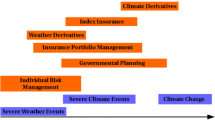Abstract
Rising global temperatures are leading to an increase in the number of extreme events and losses (http://www.epa.gov/climatechange/science/indicators/). Accurate estimation of these extreme losses with the intention of protecting themselves against them is critical to insurance companies. In a previous paper, Gulati et al. (2014) discussed probable maximum loss (PML) estimation for the Florida Public Hurricane Loss Model (FPHLM) using parametric and nonparametric methods. In this paper, we investigate the use of semi-parametric methods to do the same. Detailed analysis of the data shows that the annual losses from FPHLM do not tend to be very heavy tailed, and therefore, neither the popular Hill’s method nor the moment’s estimator work well. However, Pickand’s estimator with threshold around the 84th percentile provides a good fit for the extreme quantiles for the losses.













Similar content being viewed by others
References
Beirlant J, Dierckx G, Goegebeur Y, Matthys G (1999) Tail index estimation and an exponential regression model. Extremes 2:177–200
Dekkers A, Einmahl J, de Haan L (1989) A moment estimator for the index of an extreme-value distribution. Ann Stat 17:1833–1855
De Haan L, Peng L (1998) Comparison of tail index estimators. Statistica Neerlandica 52(1):60–70
Gardes L, Girard S, Lekina A (2010) Functional nonparametric estimation of conditional extreme quantiles. J Multivar Anal 101(2):419–433
Gnedenko BV (1943) Sur la distribution limite du terme maximum d’une série aléatoire. Ann Math 44:423–453
Goegebeur Y, Beirlant J, de Wet T (2010) Kernel estimators for the second order parameter in extreme value statistics. Journal of statistical Planning and Inference 140(9):2632–2652
Ivette Gomes I, De Haan ML, Henriques Rodrigues L (2008) Tail index estimation for heavy-tailed models: accommodation of bias in weighted log-excesses. J R Stat Soc Ser B Stat Methodol 70(1):31–52
Gulati S, George F, Yang F, Kibria BMG, Hamid S (2014) Estimating Extreme Losses for the Florida Public Model. Sri Lankan Journal of Statistics 5:247–271
Hamid, S., Kibria, B. M. G, Gulati, S. et al. (2008). Public hurricane loss evaluation models: predicting losses of residential structures in the State of Florida, JSM 2008 proceedings 2008.
Hamid S, Kibria BMG, Gulati S et al (2010) Predicting losses of residential structures in the state of Florida by the public hurricane loss evaluation models with discussion. Statistical Methodology 7:552–573
Henriques-Rodrigues L, Gomes MI (2009) High quantile estimation and the PORT methodology. Revstat 7(3):245–264
Hill BM (1975) A simple approach to inference about the tail of a distribution. Annals of Statististics 3:1163–1174
Hall P (1982) On some simple estimates of an exponent of regular variation. Journal of Royal Statististical Society 44(1):37–42
Matthys G, Bierlant J (2003) Estimating the extreme value index and high quantiles with exponential regression models. Stat Sin 13:853–880
Ndao P, Diop A, Dupuy J-F (2003) Nonparametric estimation of the conditional tail index and extreme quantiles under random censoring. Computational Statistics & Data Analysis 79(63–79):2014
Pickands J III (1975) Statistical inference using extreme order statistics. Ann Stat 3:119–131
Smith AB, Katz RW (2013) US billion-dollar weather and climate disasters: data sources, trends, accuracy and biases. Nat Hazards 67(2):387–410
Yang, Fan, Kibria, B. M. G, and Gulati, Sneh (2011). Estimation of extreme quantiles of catastrophe losses through some extreme value distributions. JSM 2011 Proceedings.
Weissman I (1978) Estimation of parameters and larger quantiles based on the k largest observations. Journal of the American Statististical Association 73:812–815
Acknowledgements
The authors are grateful to the editor and an anonymous referee for their comments which helped improve this paper greatly.
Author information
Authors and Affiliations
Corresponding author
Rights and permissions
About this article
Cite this article
Gulati, S., George, F. & Hamid, S. Estimating extreme losses for the Florida Public Hurricane Model—part II. Theor Appl Climatol 131, 1191–1202 (2018). https://doi.org/10.1007/s00704-016-2029-x
Received:
Accepted:
Published:
Issue Date:
DOI: https://doi.org/10.1007/s00704-016-2029-x




